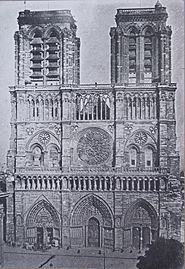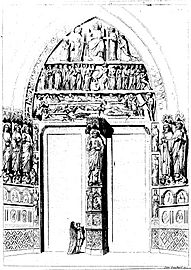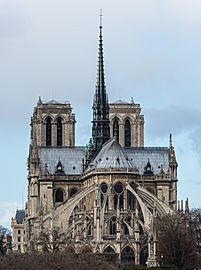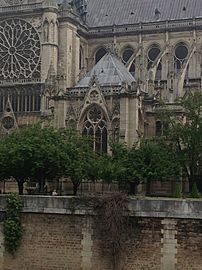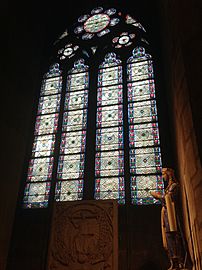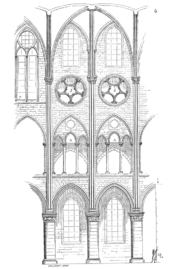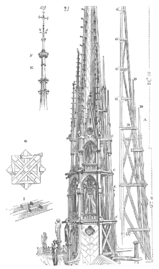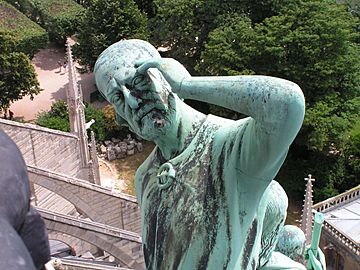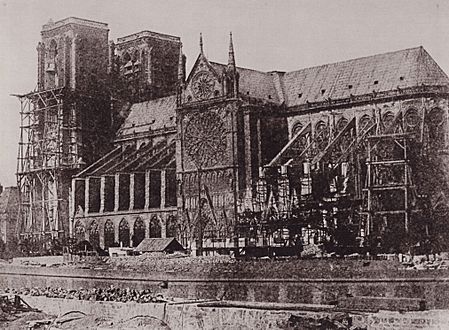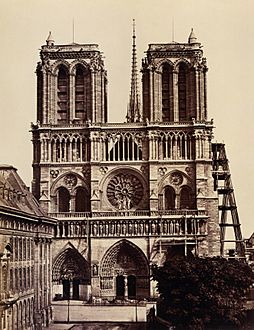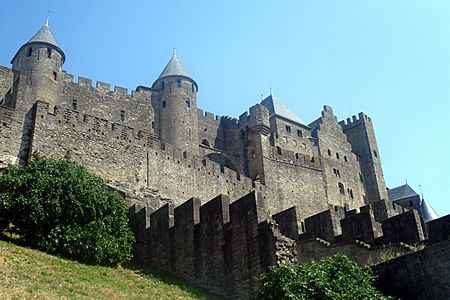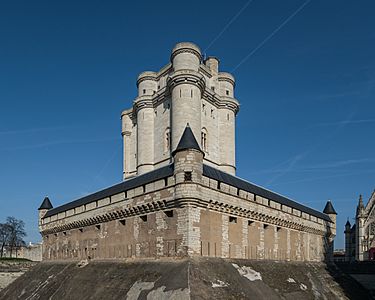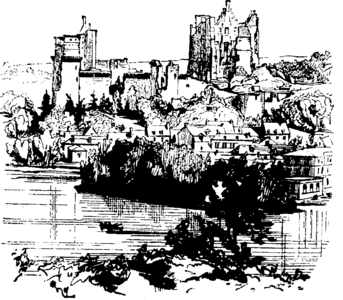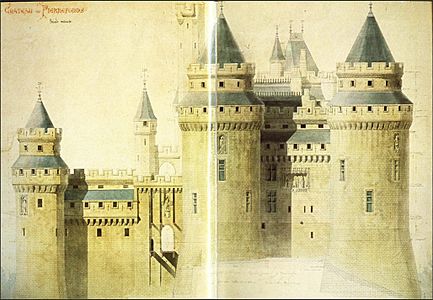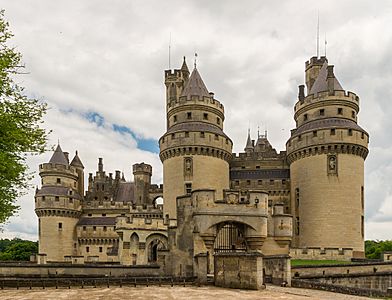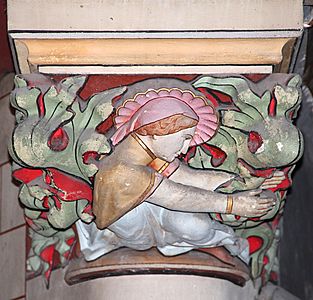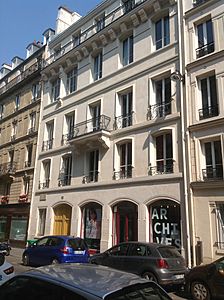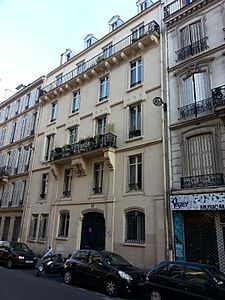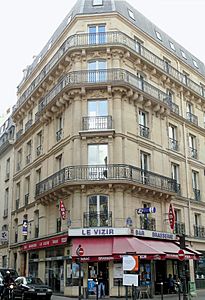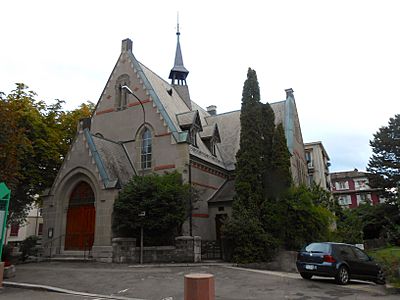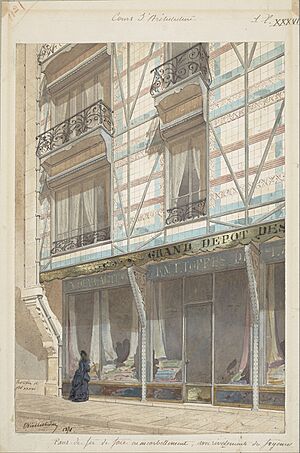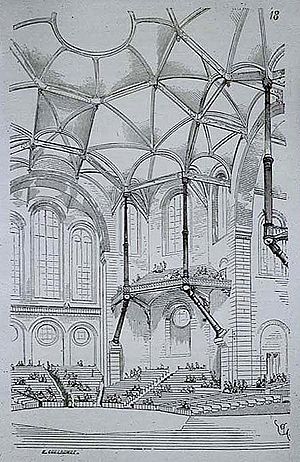Eugène Viollet-le-Duc facts for kids
Quick facts for kids
Eugène Viollet-le-Duc
|
|
|---|---|
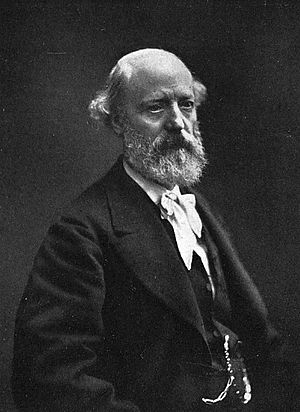
Photograph by Nadar
|
|
| Born |
Eugène Emmanuel Viollet-le-Duc
27 January 1814 Paris, France
|
| Died | 17 September 1879 (aged 65) Lausanne, Switzerland
|
| Nationality | French |
| Occupation | Architect |
| Awards | Royal Gold Medal (1864) |
| Signature | |
Eugène Emmanuel Viollet-le-Duc (27 January 1814 – 17 September 1879) was a famous French architect and writer. He is best known for restoring many important buildings from the Middle Ages in France. Some of his biggest projects included Notre-Dame de Paris, the Basilica of Saint Denis, Mont Saint-Michel, Sainte-Chapelle, and the old city walls of Carcassonne.
His ideas about how buildings should be designed, especially about how their shape should fit their purpose, greatly influenced many architects. This included artists from the Art Nouveau movement like Antoni Gaudí and Victor Horta. He also inspired early modern architects such as Frank Lloyd Wright and Mies van der Rohe. Even Le Corbusier, a very important modern architect, called Viollet-le-Duc the "father of modern architecture." His work also influenced the Arts and Crafts movement in England.
Contents
- Early Life and Learning
- First Restoration Projects
- Sainte-Chapelle and Amboise
- Restoring Notre-Dame de Paris
- Saint Denis and Amiens
- Big Projects for the Emperor
- Later Years and Influence
- War and Exile
- Writer and Thinker
- Family Life
- His Ideas on Restoration
- Gothic vs. Classical Styles
- Buildings Designed by Viollet-le-Duc
- Major Restoration Projects
- Architectural Ideas and New Designs
- Military Career and Influence
- His Legacy
- Images for kids
- See also
Early Life and Learning
Eugène Viollet-le-Duc was born in Paris in 1814. His grandfather was an architect, and his father worked for the king, managing royal homes. His uncle, Étienne-Jean Delécluze, was a painter and art critic. Eugène grew up in a family that loved art and culture.
When he was young, Eugène met Prosper Mérimée, a writer who later became very important for his career. In 1829, Eugène went to college but chose not to join the École des Beaux-Arts. This famous art school taught a very strict way of copying old Roman and Greek styles. Eugène preferred to learn by doing. He worked in architectural offices and spent a lot of time drawing medieval churches around Paris.
In 1830, at just 16, he took part in the July Revolution that changed the French government. After this, his father became the head of royal residences. The new government created a special job: Inspector General of Historic Monuments. Eugène's uncle took him on a long trip across France to see many old buildings. He came back with many detailed drawings and paintings of churches and monuments.
Back in Paris, he lived with his family in the Tuileries Palace. He still refused to go to the École des Beaux-Arts, saying it made all architects too similar. He was a very skilled artist and kept traveling to draw medieval buildings. In 1834, he married Élisabeth Templier. He also became a professor at the Royal School of Decorative Arts, which gave him a steady income.
With money from his drawings, Viollet-le-Duc traveled to Italy to see famous sites like Rome and Venice. In 1838, he showed some of his drawings at the Paris Salon. He also started working on a travel book called Picturesque and romantic images of the old France, creating almost 300 engravings for it.
First Restoration Projects
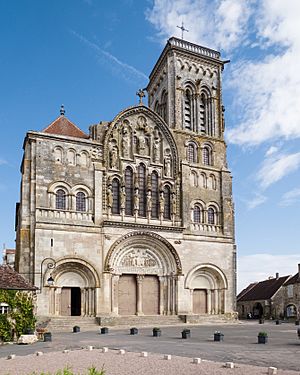
In 1838, Eugène was asked to help with the French National Archives. Soon after, Prosper Mérimée, who was now in charge of historic monuments, asked him to work on the Vézelay Abbey. This church was in terrible condition. It had been damaged by wars and revolutions, and parts of it were falling down. Many thought it was impossible to save.
Viollet-le-Duc was only 24 and didn't have an architecture degree, but he took on the challenge. At that time, no one had really studied how medieval buildings were made, and there were no schools for restoration. He had to figure out why the church was collapsing and how to make it strong again. He made the roof lighter and built new arches to support the structure.
Some people later criticized his changes, but his supporters said that without them, the roof would have fallen. Mérimée's assistant praised Viollet-le-Duc, saying he arrived "just in time" to save the church. This huge restoration project at Vézelay lasted for 19 years.
Sainte-Chapelle and Amboise
Because of his success at Vézelay, Viollet-le-Duc got many more projects. In 1840, he started restoring Sainte-Chapelle in Paris with his friend, architect Jean-Baptiste Lassus. This beautiful chapel had been used as a storage building after the French Revolution.
In 1843, King Louis Philippe asked him to restore the stained glass windows at the Château of Amboise. This chapel held the tomb of Leonardo da Vinci. Sadly, these windows were destroyed during World War II.
Viollet-le-Duc also traveled with Mérimée on inspection tours, drawing buildings and writing detailed reports. He became a leading expert on French medieval architecture. His Medieval Dictionary, with over 4,000 drawings, is still a huge collection of information on the subject.
Restoring Notre-Dame de Paris
In 1844, Viollet-le-Duc and Lassus won a competition to restore Notre-Dame Cathedral in Paris. This huge project lasted 25 years. Many statues on the front of the cathedral had been damaged or destroyed during the French Revolution.
They planned to rebuild parts of the interior to their original medieval height. They also wanted to remove some marble decorations added later. Mérimée told them to be very careful, saying a bad restoration could be worse than centuries of damage. Viollet-le-Duc also suggested rebuilding the original medieval spire, which had been removed because it was unstable.
Once the plan was approved, Viollet-le-Duc made detailed drawings and photos of the existing decorations. Then, sculptors in his workshop created new statues of saints, gargoyles, and other parts, based on his designs and old examples. He also designed a new treasury for the cathedral in the Gothic style.
The original bells had been melted down for cannons. Viollet-le-Duc had new bells made for the north tower. The new spire was built taller and stronger. It was decorated with statues of the apostles, and the face of Saint Thomas, the patron saint of architects, looked a lot like Viollet-le-Duc himself. Sadly, this spire was destroyed in the Notre-Dame de Paris fire in 2019.
Saint Denis and Amiens
While working in Paris, Viollet-le-Duc also traveled a lot to check on more than 20 other restoration projects. These included the Basilica of Saint-Sernin, Toulouse and the Basilica of Saint-Denis near Paris. At Saint-Denis, he had to oversee the demolition of a tower that was cracking. He then focused on restoring the church's interior, including the burial chamber of French kings.
In 1849, he became the architect for the restoration of Amiens Cathedral, one of France's largest churches. It had been built over many centuries in different styles. He aimed to save each part's unique character while making sure everything worked together.
Big Projects for the Emperor
-
The walled town of Carcassonne (restored 1853–1879)
When Napoléon III became Emperor of France in 1851, it helped Viollet-le-Duc's projects. His friend Mérimée introduced him to the Emperor. He continued work on the Reims Cathedral and Amiens Cathedral. In Amiens, he removed later decorations to make the interior truly Gothic again. The Empress even offered to pay two-thirds of the restoration cost.
In 1853, he started restoring the Château de Vincennes, a castle near Paris. He also began a major project on the medieval walls of Carcassonne. These walls were very old, built by different groups over centuries. Viollet-le-Duc removed later additions and restored the gates, walls, and towers to their original medieval look. Carcassonne became a great example of medieval military architecture and a popular tourist spot.
Napoleon III also gave more money for Notre-Dame. Viollet-le-Duc's workshop created new dragons, gargoyles, and other decorative elements for the cathedral. He also designed six railway coaches with a neo-Gothic style for the Emperor. Two of these cars still exist today.
The Emperor asked Viollet-le-Duc to restore a medieval castle for his own use. Viollet-le-Duc chose Château de Pierrefonds, a castle started in 1396 but later taken apart. From 1857, he designed a completely new castle on the ruins. It wasn't an exact copy, but a castle that captured the spirit of the Gothic style, with fancy decorations and modern comforts. Pierrefonds influenced other famous castles, like Neuschwanstein Castle in Bavaria.
Viollet-le-Duc also designed some new private homes and buildings in Paris. He even competed to design the new Paris Opera, but another architect, Charles Garnier, won.
Napoleon III also asked him for help with archaeological tasks. When the Emperor wanted to mark the site of the Battle of Alesia, where Julius Caesar defeated the Gauls, Viollet-le-Duc found the exact battlefield. He also designed the metal frame for a large statue of the Gallic chief Vercingetorix there. He later designed a similar frame for the much larger Statue of Liberty, but he died before it was finished.
Later Years and Influence
In 1863, Viollet-le-Duc became a professor at the École des Beaux-Arts, the school he had refused to attend. Many professors there didn't like his ideas because they were different from the traditional style. He resigned in 1863 and continued his work and teaching outside the school. He even helped create a new school, the École Spéciale d'Architecture, in 1865.
In 1864, he finished his most important project, the restoration of Notre-Dame. He also completed the first part of the restoration of the Cathedral of Saint Sernin in Toulouse. He even designed a new church, the neo-Gothic Church of Saint-Denis de l'Estree.
From 1866 to 1870, his main project was turning Pierrefonds from a ruin into a royal home. He also started studying the geology and geography of the Mont Blanc area in the Alps. In July 1870, while in the Alps, he learned that war had started between Prussia and France.
War and Exile
When the Franco-Prussian War began, Viollet-le-Duc quickly returned to Paris. He offered his skills as a military engineer and became a colonel, helping to prepare Paris's defenses. The war was very difficult for France. He wrote about the disorganization and lack of trust in the army. He fought in a battle in January 1871, but the French lost, and Paris surrendered.
After the war, he left Paris to avoid being drafted by the Paris Commune, a revolutionary government. He went to Pierrefonds and then to Lausanne, Switzerland. There, he enjoyed his love for mountains, making detailed maps and drawings of the Alps. He also helped restore the cathedral in Lausanne.
He later returned to Paris after the Commune was defeated. Many public buildings had been burned. The new government asked him to design a plaque for Notre-Dame to honor those killed by the Commune. However, his expertise wasn't used much for rebuilding the many other damaged government buildings.
Writer and Thinker
Throughout his life, Viollet-le-Duc wrote over 100 books and articles on architecture, history, and more. Some of his books became very popular, like Dictionary of French Architecture from 11th to 16th Century and Entretiens sur l'architecture.
In Entretiens sur l'architecture, he wrote about using new materials like iron. He believed that buildings should be designed based on their purpose, not just a certain style. This book was translated into English and became very influential in the United States. The architect Louis Sullivan, who helped invent the skyscraper, often used Viollet-le-Duc's idea: "Form follows function."
His final major restoration project was the Lausanne Cathedral in Switzerland. He rebuilt it between 1873 and 1876. His work on the bell tower was later changed, but his structural ideas remained.
His reputation spread beyond France. When Strasbourg Cathedral was damaged in the Franco-Prussian War, the German government asked for his advice on its restoration. He told them their plans for a new tower didn't fit the cathedral's original style, and they accepted his advice.
In his final years, he continued to oversee restoration projects. He also spent more time studying the Alps and campaigned for re-foresting the mountains. He died in Lausanne, Switzerland, on September 17, 1879, and was buried there.
Family Life
Viollet-le-Duc married Elisabeth Tempier in 1834. They had two children, but they separated a few years later. He was often traveling for his work. His great-granddaughter, Geneviève Viollet-le-Duc, was also a writer.
His Ideas on Restoration
Viollet-le-Duc had a famous idea about restoration. He said, "To restore a building is not to maintain it, repair it or remake it: it is to re-establish it in a complete state which may never have existed at any given moment." This meant he didn't just want to fix old buildings; he wanted to bring them back to how they should have been at their best, even if that exact state never existed.
He believed restoration should be based on scientific research, using old plans and photos. It should also make the building stronger and last longer, even if it meant using new materials or slightly changing the original design. He also thought that older changes to a building should be kept, unless they made the building unstable or ruined its historical value.
He learned from medieval architecture that buildings should be carefully planned, with every part serving a purpose. He thought modern buildings should also be designed this way.
Gothic vs. Classical Styles
Viollet-le-Duc often argued with the ideas of the École des Beaux-Arts, which favored classical Roman and Greek styles. He believed that Gothic architecture, which came from France, was better suited for his country.
He explained that Gothic churches were built so that all the weight and forces were pushed outwards. This allowed for large open spaces inside. The flying buttresses and supports held up the whole structure, making it strong and stable. He admired how every part of a Gothic building had a function and worked together.
Buildings Designed by Viollet-le-Duc
-
Scots Kirk, Avenue de Rumine 26, Lausanne, Switzerland (1879)
Viollet-le-Duc also designed and built new structures. Here are some examples:
- His own home and studio in Paris (1862)
- Maison Courmont in Paris
- Other buildings in Paris, like at 15 rue de Douai
- Scots Kirk (a church) in Lausanne, Switzerland (1879)
- Château d'Abbadia in Hendaye, France
- Saint-Gimer Church in Carcassonne
- Église Saint-Denis-de-l'Estrée near Paris
Major Restoration Projects
Here are some of the most important buildings Viollet-le-Duc restored:
- Basilica of St. Mary Magdalene in Vézelay
- Notre-Dame in Paris
- Sainte-Chapelle in Paris
- Basilica of St. Denis near Paris
- Basilica of St. Nazarius and St. Celsus in Carcassonne
- Basilica of St. Sernin, Toulouse
- Notre-Dame in Lausanne, Switzerland
- Château de Roquetaillade
- Fortified city of Carcassonne
- Château de Pierrefonds
- Château de Vincennes, Paris
- Château d'Amboise, Amboise
Architectural Ideas and New Designs
Many people see Viollet-le-Duc as one of the first thinkers of modern architecture. He believed that buildings should be designed honestly, meaning their outside look should show how they are built. He also thought that the design should start with the building's purpose and plan, and then add decorations. If this meant the building wasn't perfectly symmetrical, that was fine.
He used ideas from Gothic architecture and applied them to new materials like cast iron. He also looked at natural shapes, like leaves and animal skeletons, for inspiration. His drawings of iron structures were very new for his time. His designs, especially those using iron, influenced the Art Nouveau movement and architects like Hector Guimard and Antoni Gaudí. His writings also inspired American architects like Frank Lloyd Wright.
Military Career and Influence
Viollet-le-Duc also had a military career, especially during the Franco-Prussian War (1870–71). He was so affected by the war that he later wrote a book called Annals of a Fortress. In this book, he described how an imaginary castle, Le Roche-Pont, would be defended.
This book greatly influenced French military thinking. Viollet-le-Duc's ideas about how artillery (large guns) affected defenses were so accurate that they were used to plan the defense of Verdun before World War I and the Maginot Line before World War II. His theories emphasized that artillery and strong fortresses were very important for an army's defense.
His Legacy
The English architect Benjamin Bucknall translated many of Viollet-le-Duc's books into English, helping to spread his ideas in Great Britain. The English designer William Burges was also greatly influenced by him, especially in his designs for his own home, The Tower House, and Castell Coch in Wales.
There have been several exhibitions about Viollet-le-Duc's work. In 2014, he was featured in a Google Doodle on his birthday.
Images for kids
-
Notre-Dame de Paris (restored 1845–1870)
-
The walled town of Carcassonne (restored 1853–1879)
-
Basilica of Saint-Sernin, Toulouse (restored in the 1860s to the 1880s)
See also
 In Spanish: Eugène Viollet-le-Duc para niños
In Spanish: Eugène Viollet-le-Duc para niños



